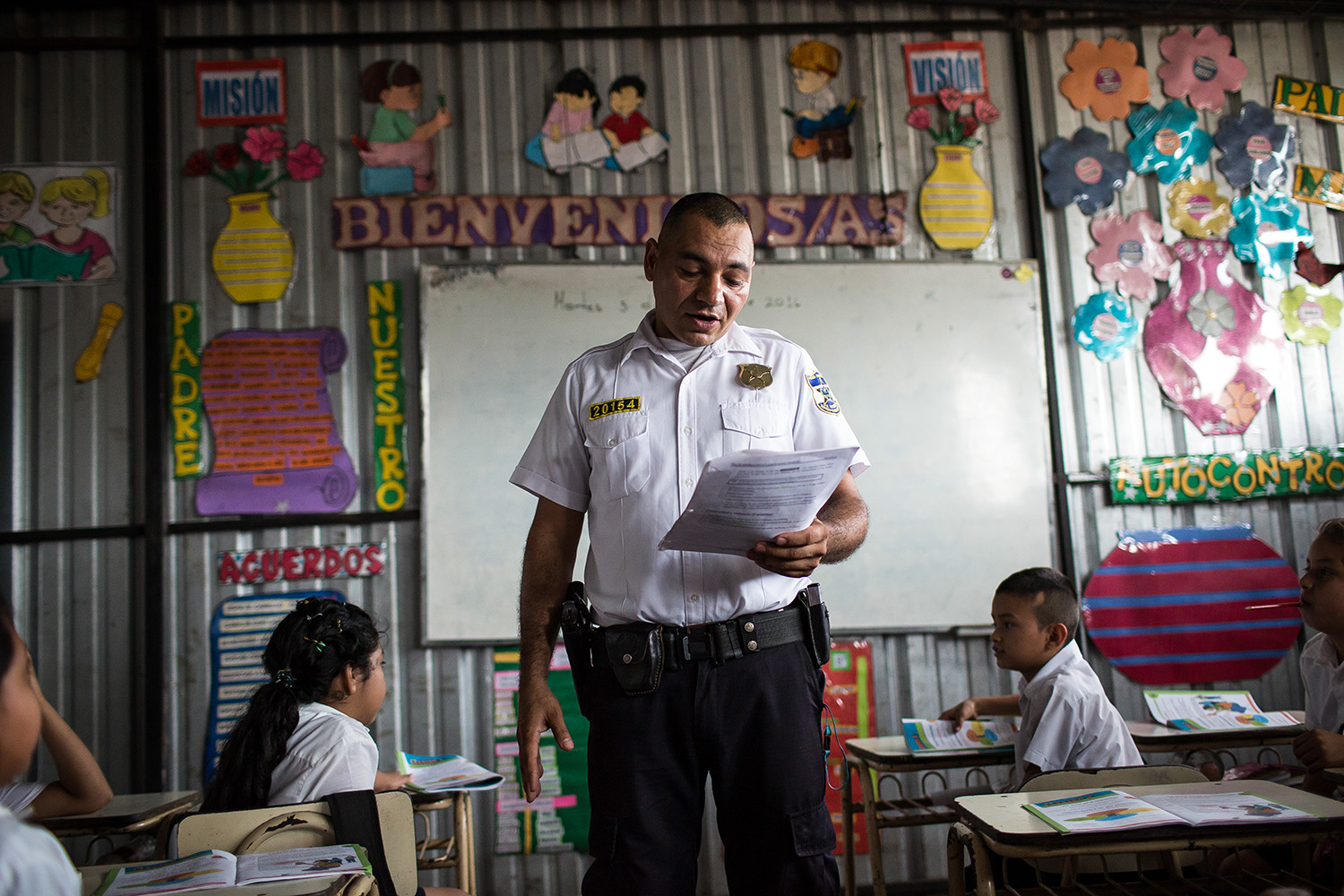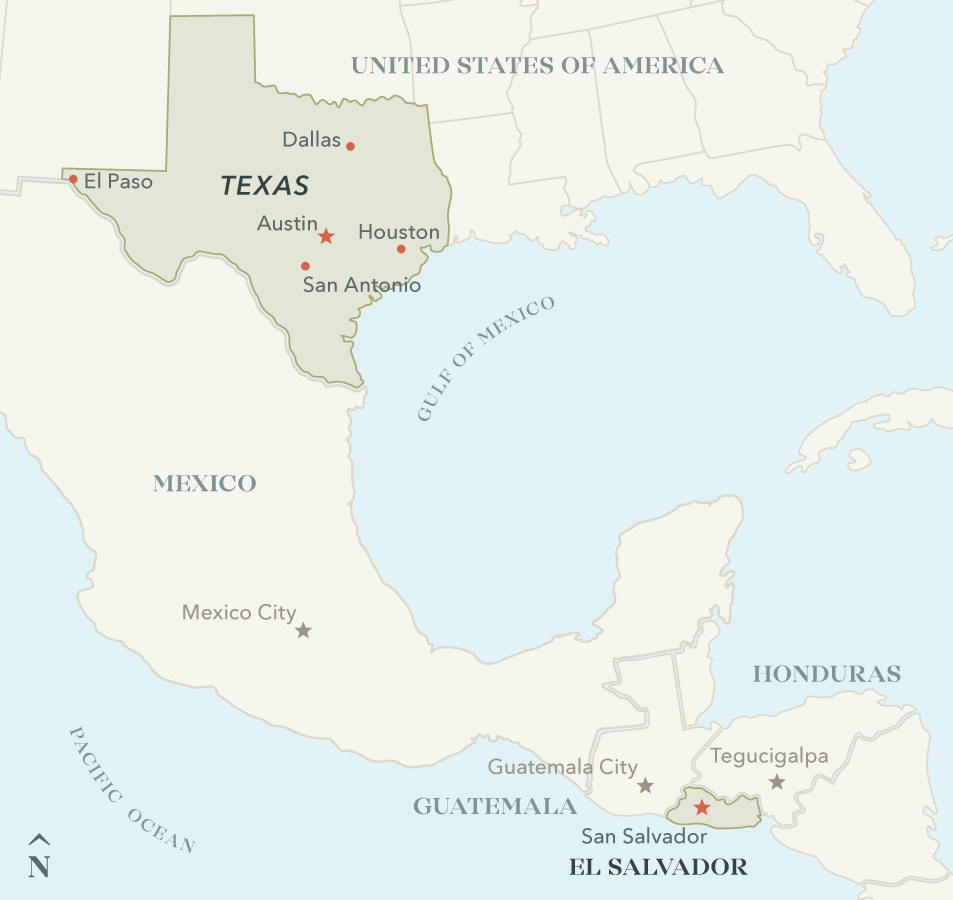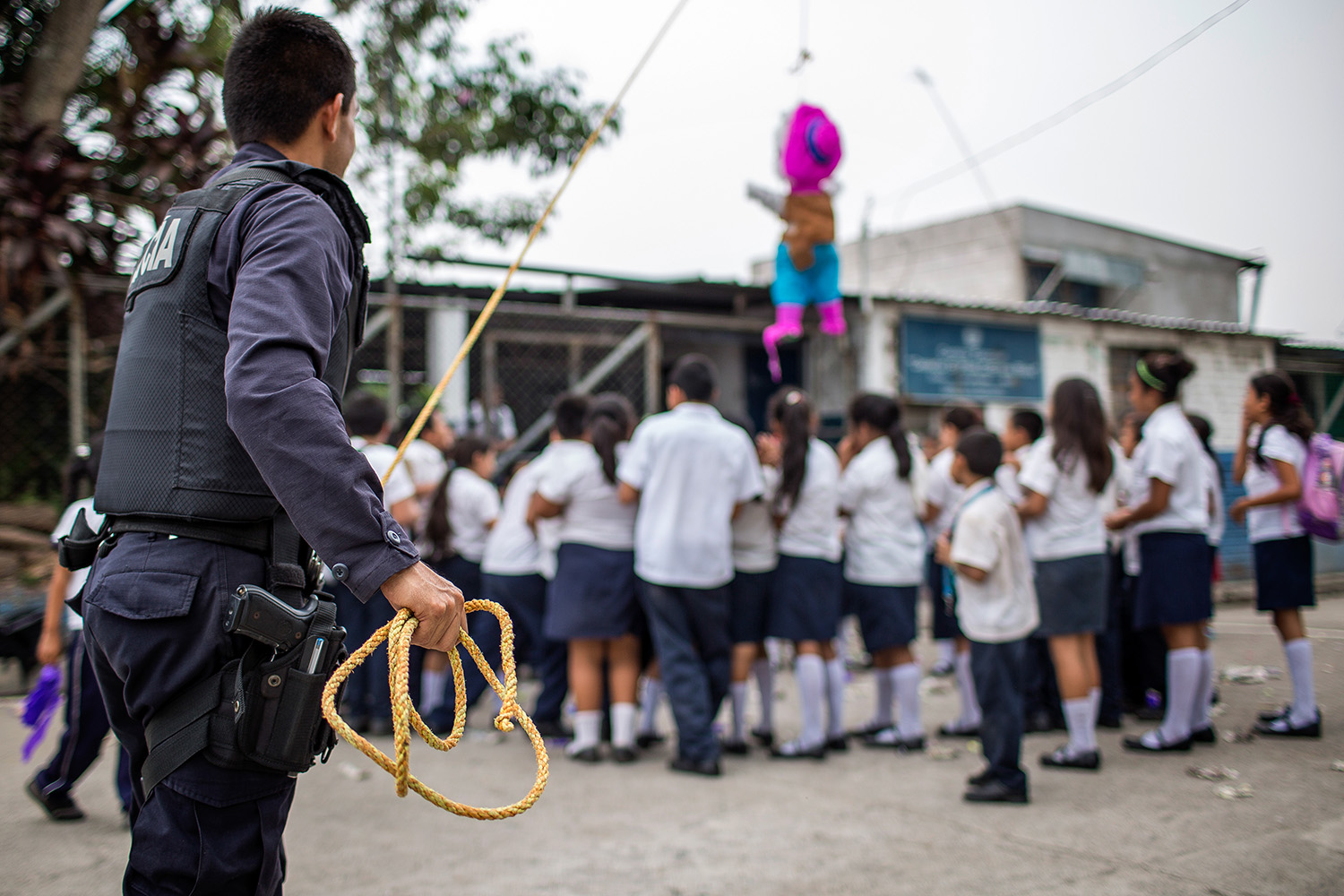/https://static.texastribune.org/media/images/2016/10/20/MHN_TT_ES_39_TT_MDN.jpg)

LOURDES, El Salvador — In a tiny classroom in a small hamlet in the murder capital of the world, the U.S. government is testing the theory — one child at a time — that helping young Central Americans at home might convince them to stay put rather than joining the flood of migrants fleeing for the U.S.-Mexico border.
One is an 11-year-old Salvadoran girl named Yaritza, who stood in front of her fifth-grade classmates this spring with a U.S.-provided workbook in her hands. On the open page was a list of questions based on the reading materials.
Question No. 2: “What have you heard recently about gangs and violence?”
Her answer: “That there are a lot of murders.”
It’s something of an understatement. At last count, El Salvador had the highest murder rate on the planet and, if apprehensions on the southern U.S. border are a good guide, Salvadorans are migrating to the United States at higher rates than the citizens of any other Latin American country, according to a Texas Tribune analysis.
Policymakers are hoping that anti-gang initiatives like the one playing out in Yaritza’s high-risk school in tiny Caserio El Pital, located in one of the country's most violent regions, will help reduce crime by stopping kids from joining the street gangs that rule huge swaths of territory here.

The materials and instruction she receives — courtesy of the U.S. taxpayer — are part of a major foreign assistance effort. This particular program, called GREAT, for Gang Resistance Education And Training, was developed for gang prevention in the United States and is now being used abroad.
Other U.S.-funded programs aimed at helping Central Americans help themselves cover areas such as job training, youth activity centers and a variety of law enforcement training and infrastructure improvement initiatives.
It’s essentially nation building in the United States' own hemisphere, aimed at longtime allies experiencing orgies of gang violence and deep poverty — particularly in the Northern Triangle of El Salvador, Honduras and Guatemala. Immigrants from those three countries are pushing apprehensions of non-Mexicans at the southern U.S. border into uncharted statistical territory.
Using foreign aid to reduce pressure on the U.S-Mexico border is a no-brainer for Democratic U.S. Rep. Henry Cuellar of Laredo, who helped get nearly $1 billion in assistance for the region as part of last year’s bipartisan budget agreement. He says that amount is still small compared to the $18 billion a year (based on an analysis of 2012 spending) the United States spends on border security, much of it going to catch Central Americans running for their lives.
“Either we spend a little bit of money over there or we’re going to spend much money, a lot of money, over here,” Cuellar told the Tribune.
The GREAT program is funded by the U.S. State Department’s Bureau of International Narcotics and Law Enforcement Affairs, better known by its three-letter acronym, INL. The agency picked Lourdes, in the municipality of Colon — ranked third in the number of homicides last year — to launch its first “model precinct” program in the country in 2009. Officials say nearly 30,000 students have since graduated from the anti-gang program in more than 50 schools in the area. After a recent expansion, the Lourdes police jurisdiction being helped by the State Department program is about the size of Dallas and contains more than 150,000 people.

Besides funding the GREAT initiative, INL’s model precinct program helped Lourdes build a new prisoner holding cell, buy dozens of new patrol vehicles and motorcycles and upgrade its gang intelligence-gathering capabilities, U.S. and Salvadoran officials said.
“When we first went to Lourdes they had no radios, they had no vehicles to drive in, and the stench was so bad in the sleeping accommodations because they go in there for three or four days at a time,” said James Rose, INL’s regional adviser who works out of the U.S. Embassy in San Salvador. “They were horrible.”
The U.S. funding showered on Lourdes — about $2 million in the past seven years — has transformed the way police conduct their business here, said Sub-Inspector Melbin Medina, chief of prevention for the National Civil Police in Lourdes.
The money replaced a holding cell where sometimes 300 prisoners were stuffed into a facility meant for 50. It built a youth soccer league, complete with two mini buses, for kids in the GREAT program. And it dramatically improved the police's ability to target high-value gang members.
“If we talk about 2009 and before, when the police detained someone or brought them here because they didn’t have an ID, and let’s say we suspected there was an outstanding arrest warrant for this person — all we could do is check to see if his name was in our system. And if the name he gave us wasn’t in there we would have to let him go,” Medina said. “Now when we bring suspects in, or if we have one of the mobile fingerprint readers that the INL gave us, then it shows us whether there is an arrest warrant. It makes it easier for us, and then we don’t let the wrong people go.”
Not everything has gone according to plan. Rose said INL had to cut back on vehicle and truck purchases because local officials didn’t have the budget to fix them when they broke down.
“They drive them ‘til they break and then they ask for new vehicles,” he said. The solution: buying police motorcycles and funding roving maintenance units that can pick them up and conduct routine maintenance on site.
Law enforcement help isn’t the only focus of U.S. government aid here. The U.S. Agency for International Development, funds programs aimed at reducing migration flows by attacking the socioeconomic problems that serve as triggers.
“The factors that we’re looking at directly are the same factors that are fueling migration,” said Larry Sacks, USAID’s mission director in El Salvador. “By addressing those issues, by helping to support a safer, more prosperous subregion here in Central America and El Salvador, our hypothesis is that it will reduce the migration flows.”
As with the GREAT program in Lourdes, that hypothesis is being put to the test in Nejapa, about a half hour north of San Salvador. That’s where USAID is partnering with Nejapa City Hall to teach young Salvadoran adults — 18- to 29-year-olds — a variety of skills, from air conditioning repair to cooking, through a program called FORMATE — which translates to “Educate Yourself.”

A related program housed at the same facility, the Microsoft Academy, provides training in basic computer skills. The U.S. software giant provides some funding for the program.
The joint U.S.-Salvadoran program is targeting vulnerable people who wouldn’t otherwise get the training they need. Merely leaving your own gang-infested neighborhood can get you killed here, particularly if it involves crossing into a different gang’s stronghold. Even people who have nothing to do with the gangs often wind up getting shot because they’re taken for spies or informants.
“There are kids in our municipality that can’t go to the center of San Salvador,” said Carlos Quintanilla, director of FORMATE and the Microsoft Academy. “Because of that, they become vulnerable. They can’t study. They can’t train.”
During a tour of the vocational center this spring, about a dozen students were taking a cooking certification class, and several said they hoped to launch their own food-service companies.
Katerin Panessa Ruballo, 18, admitted she’s thought often about going to the United States, where she has numerous family members, but she wants to start her own business in her own homeland.
“Because of the violence, yes, I have thought about migrating,” she said. “But when I see the situation at the border, which is very hard, I don’t want to go. I grew up in my country, and I’ll get ahead in my country.”
That’s the kind of response U.S. authorities like to hear, but it’s clear from recent border apprehension figures that they have their work cut out for them. Migration from the Northern Triangle has been on the rise since 2011 and doesn’t seem to be slowing despite the foreign aid and efforts in Mexico to crack down on Central American migrants.
In Nejapa, Quintanilla says about 38 percent of the people who graduate from the vocational training programs have gone on to find jobs. Sacks, the USAID mission director, said other, longer-term programs have higher success rates, but even at lower percentages he said it’s worth the effort; USAID has helped more than 10,000 small and medium-sized businesses here, creating 21,000 new jobs and generating more than $140 million in sales and exports, officials say.
“Any additional jobs that can come out of a two-to-four week program is, in my opinion, a success,” Sacks said. “It’s something that could potentially change the lives of those kids.”
Sacks said the most crucial element in determining success is not how money the United States spends but how much buy-in and participation they get from locals.
“We’re not going to achieve results unless the local commitment is there,” he said. “We can’t do this alone.”
According to figures provided by the U.S. Embassy in San Salvador, the private sector in El Salvador has contributed $72 million to USAID programs. Sacks also noted that in Nejapa, the office of Mayor Sergio Quijada provides most of the funding for the vocational training centers, for example.
Quijada was asked what he would tell U.S. voters who might take a skeptical view of spending American tax dollars on job training in El Salvador.
“We aren’t taking money from the United States without investing in it ourselves,” he said. “It’s not just a gift. We’re doing this together.”
Reporter Julian Aguilar contributed to this story.
This story is part of The Texas Tribune's yearlong Bordering on Insecurity project.
Information about the authors
Learn about The Texas Tribune’s policies, including our partnership with The Trust Project to increase transparency in news.
/https://static.texastribune.org/media/profiles/Jay_at_Cloak_TT.jpg)